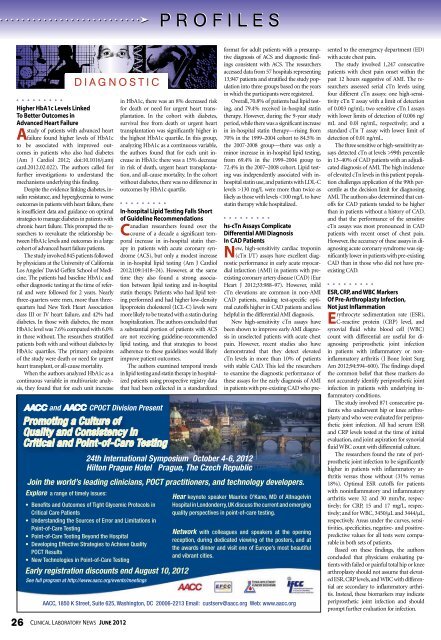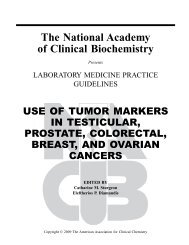June 2012 - American Association for Clinical Chemistry
June 2012 - American Association for Clinical Chemistry
June 2012 - American Association for Clinical Chemistry
You also want an ePaper? Increase the reach of your titles
YUMPU automatically turns print PDFs into web optimized ePapers that Google loves.
higher hba1c levels linked<br />
To better outcomes in<br />
advanced heart failure<br />
study of patients with advanced heart<br />
a<br />
failure found higher levels of HbA1c<br />
to be associated with improved outcomes<br />
in patients who also had diabetes<br />
(Am J Cardiol <strong>2012</strong>; doi:10.1016/j.amj<br />
card.<strong>2012</strong>.02.022). The authors called <strong>for</strong><br />
further investigations to understand the<br />
mechanisms underlying this finding.<br />
Despite the evidence linking diabetes, insulin<br />
resistance, and hyperglycemia to worse<br />
outcomes in patients with heart failure, there<br />
is insufficient data and guidance on optimal<br />
strategies to manage diabetes in patients with<br />
chronic heart failure. This prompted the researchers<br />
to reevaluate the relationship between<br />
HbA1c levels and outcomes in a large<br />
cohort of advanced heart failure patients.<br />
The study involved 845 patients followed<br />
by physicians at the University of Cali<strong>for</strong>nia<br />
Los Angeles’ David Geffen School of Medicine.<br />
The patients had baseline HbA1c and<br />
other diagnostic testing at the time of referral<br />
and were followed <strong>for</strong> 2 years. Nearly<br />
three-quarters were men, more than threequarters<br />
had New York Heart <strong>Association</strong><br />
class III or IV heart failure, and 42% had<br />
diabetes. In those with diabetes, the mean<br />
HbA1c level was 7.6% compared with 6.0%<br />
in those without. The researchers stratified<br />
patients both with and without diabetes by<br />
HbA1c quartiles. The primary endpoints<br />
of the study were death or need <strong>for</strong> urgent<br />
heart transplant, or all-cause mortality.<br />
When the authors analyzed HbA1c as a<br />
continuous variable in multivariate analysis,<br />
they found that <strong>for</strong> each unit increase<br />
diagNostiC<br />
and CPOCT Division Present<br />
Promoting a Culture of<br />
Quality and Consistency in<br />
Critical and Point-of-Care Testing<br />
26 CliniCal laboratory news <strong>June</strong> <strong>2012</strong><br />
p r o f i L e s<br />
p r o f i L e s<br />
in HbA1c, there was an 8% decreased risk<br />
<strong>for</strong> death or need <strong>for</strong> urgent heart transplantation.<br />
In the cohort with diabetes,<br />
survival free from death or urgent heart<br />
transplantation was significantly higher in<br />
the highest HbA1c quartile. In this group,<br />
analyzing HbA1c as a continuous variable,<br />
the authors found that <strong>for</strong> each unit increase<br />
in HbA1c there was a 15% decrease<br />
in risk of death, urgent heart transplantation,<br />
and all-cause mortality. In the cohort<br />
without diabetes, there was no difference in<br />
outcomes by HbA1c quartile.<br />
in-hospital lipid Testing falls short<br />
of guideline recommendations<br />
canadian researchers found over the<br />
course of a decade a significant temporal<br />
increase in in-hospital statin therapy<br />
in patients with acute coronary syndrome<br />
(ACS), but only a modest increase<br />
in in-hospital lipid testing (Am J Cardiol<br />
<strong>2012</strong>;109:1418–24). However, at the same<br />
time they also found a strong association<br />
between lipid testing and in-hospital<br />
statin therapy. Patients who had lipid testing<br />
per<strong>for</strong>med and had higher low-density<br />
lipoprotein cholesterol (LCL-C) levels were<br />
more likely to be treated with a statin during<br />
hospitalization. The authors concluded that<br />
a substantial portion of patients with ACS<br />
are not receiving guideline-recommended<br />
lipid testing, and that strategies to boost<br />
adherence to these guidelines would likely<br />
improve patient outcomes.<br />
The authors examined temporal trends<br />
in lipid testing and statin therapy in hospitalized<br />
patients using prospective registry data<br />
that had been collected in a standardized<br />
<strong>for</strong>mat <strong>for</strong> adult patients with a presumptive<br />
diagnosis of ACS and diagnostic findings<br />
consistent with ACS. The researchers<br />
accessed data from 57 hospitals representing<br />
13,947 patients and stratified the study population<br />
into three groups based on the years<br />
in which the participants were registered.<br />
Overall, 70.8% of patients had lipid testing,<br />
and 79.4% received in-hospital statin<br />
therapy. However, during the 9-year study<br />
period, while there was a significant increase<br />
in in-hospital statin therapy—rising from<br />
70% in the 1999–2004 cohort to 84.5% in<br />
the 2007-2008 group—there was only a<br />
minor increase in in-hospital lipid testing,<br />
from 69.4% in the 1999–2004 group to<br />
72.4% in the 2007–2008 cohort. Lipid testing<br />
was independently associated with inhospital<br />
statin use, and patients with LDL-C<br />
levels >130 mg/L were more than twice as<br />
likely as those with levels 99th percentile<br />
in 13–40% of CAD patients with an adjudicated<br />
diagnosis of AMI. The high incidence<br />
of elevated cTn levels in this patient population<br />
challenges application of the 99th percentile<br />
as the decision limit <strong>for</strong> diagnosing<br />
AMI. The authors also determined that cutoffs<br />
<strong>for</strong> CAD patients tended to be higher<br />
than in patients without a history of CAD,<br />
and that the per<strong>for</strong>mance of the sensitive<br />
cTn assays was most pronounced in CAD<br />
patients with recent onset of chest pain.<br />
However, the accuracy of these assays in diagnosing<br />
acute coronary syndrome was significantly<br />
lower in patients with pre-existing<br />
CAD than in those who did not have preexisting<br />
CAD.<br />
esr, crP, and Wbc markers<br />
of Pre-arthroplasty infection,<br />
not just inflammation<br />
sedimentation rate (ESR),<br />
e rythrocyte<br />
C-reactive protein (CRP) level, and<br />
synovial fluid white blood cell (WBC)<br />
count with differential are useful <strong>for</strong> diagnosing<br />
periprosthetic joint infection<br />
in patients with inflammatory or non-<br />
inflammatory arthritis (J Bone Joint Surg<br />
Am <strong>2012</strong>;94:594–600). The findings dispel<br />
the common belief that these markers do<br />
not accurately identify periprosthetic joint<br />
infection in patients with underlying inflammatory<br />
conditions.<br />
The study involved 871 consecutive patients<br />
who underwent hip or knee arthroplasty<br />
and who were evaluated <strong>for</strong> periprosthetic<br />
joint infection. All had serum ESR<br />
and CRP levels tested at the time of initial<br />
evaluation, and joint aspiration <strong>for</strong> synovial<br />
fluid WBC count with differential culture.<br />
The researchers found the rate of periprosthetic<br />
joint infection to be significantly<br />
higher in patients with inflammatory arthritis<br />
versus those without (31% versus<br />
18%). Optimal ESR cutoffs <strong>for</strong> patients<br />
with noninflammatory and inflammatory<br />
arthritis were 32 and 30 mm/hr, respectively;<br />
<strong>for</strong> CRP, 15 and 17 mg/L, respectively;<br />
and <strong>for</strong> WBC, 3450/µL and 3444/µL,<br />
respectively. Areas under the curves, sensitivities,<br />
specificities, negative- and positivepredictive<br />
values <strong>for</strong> all tests were comparable<br />
in both sets of patients.<br />
Based on these findings, the authors<br />
concluded that physicians evaluating patients<br />
with failed or painful total hip or knee<br />
arthroplasty should not assume that elevated<br />
ESR, CRP levels, and WBC with differential<br />
are secondary to inflammatory arthritis.<br />
Instead, these biomarkers may indicate<br />
periprosthetic joint infection and should<br />
prompt further evaluation <strong>for</strong> infection.
















